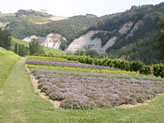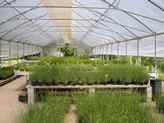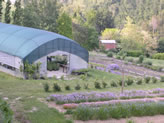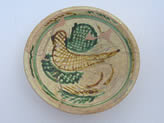Giardino delle Erbe "A. Rinaldi Ceroni" - Casola Valsenio
Via del Corso 6 48010 Casola Valsenio
Tel. 0546 73158 Fax 0546 73158
email info@ilgiardinodelleerbe.it
web http://www.ilgiardinodelleerbe.it
Apertura: da novembre a marzo: da lunedì a venerdì ore 9-12 e 14-16; aprile e maggio, settembre e ottobre: da lunedì a venerdì ore 9-12 e 14-16,30, sabato ore 15-17,30, domenica ore 10-12 e 15-17,30; da giugno ad agosto, da lunedì a venerdì ore 9-12 e 14-16,30, sabato ore 16-18,30, domenica ore 10-12 e 16-18,30 (per eventuali chiusure in caso di pioggia consultare il sito del Giardino)
Chiusura: da novembre a marzo, il sabato e la domenica; vigilia e giorno di Pasqua
Parcheggio: proprio del Giardino
Ingresso gratuito per le singole persone; ingresso a pagamento solo per gruppi e comitive (1 €).
Visite guidate e laboratori a pagamento.
Alcune zone accessibili ai diversamente abili.
Il primo nucleo però risale al 1938, quando il prof. Rinaldi Ceroni comincia la coltivazione delle prime piante officinali per la sperimentazione sperando di arrivare ad un vero e proprio Orto Botanico, orto che il professore ha seguito ingrandendolo e specializzandolo man mano fino ad arrivare - alla metà degli anni '70 - all'istituzione del Giardino Officinale, nel quale Rinaldi Ceroni riversa oltre trent'anni di studio e di esperienze, insieme ad una chiara visione sul futuro sviluppo dell'erboristeria.
Il complesso diventa in breve un punto di riferimento nazionale per la didattica, la sperimentazione e la divulgazione nel campo officinale, svolgendo anche un ruolo di valorizzazione turistica di tutta l'area.
Il Giardino, che ha subito notevoli miglioramenti, ha assunto il nome di Giardino delle Erbe e nel 2000 è stato intitolato al suo fondatore. Oggi è gestito dal Comune di Casola Valsenio il quale ne ha affidato la conduzione alla Cooperativa Montana Valle del Senio, con un'attività che spazia dalla sperimentazione scientifica in collaborazione con le Università di Bologna, Modena, Parma e Torino, alle visite didattiche e divulgative fino alla commercializzazione di piante in vaso, semi, oli essenziali e prodotti per la cucina e la cosmesi.
Il Centro di Documentazione del Giardino delle Erbe raccoglie varie parti di piante, fiori e foglie essiccati ed è in grado di svolgere la propria funzione didattica per ricercatori e studenti ma anche per tutti coloro che sono attratti solo dalla curiosità verso questo profumato e variopinto mondo.
Il Giardino conserva anche vecchi distillatori ed attrezzi d'epoca per la lavorazione delle piante officinali. Un patrimonio storico che si arricchisce in continuazione grazie alla lunga storia che lega Casola Valsenio al mondo officinale.
° ° ° ° ° ° ° ° ° ° ° ° ° ° ° ° ° ° ° ° ° ° ° ° ° ° ° ° ° ° ° ° ° ° ° ° ° ° ° ° ° ° ° ° ° ° ° ° ° ° ° °
The Herb Garden of Casola Valsenio, named after its founder Alberto Ceroni, is a botanic garden with the aim of growing and conserving plants with medicinal and aromatic properties. Owned by the Region of Emilia Romagna, it has been managed by the municipality of Casola Valsenio since the year 2000, with the collaboration of the co-operative Montana Valle Senio and the association Terre di Faenza. It was opened in 1975, but the origins of the garden go much further back in time. It was created in 1938 by professor Augusto Rinaldi Ceroni, the director of the agricultural training college, who obtained permission from the educational authorities to convert a piece of land given to the school into an experimental plot for medicinal plants, to provide practice for the students.
The garden became part of the museum network of the province o Ravenna in 2003, and has always played an important role in teaching and education.
This area of 4 hectares, divided into eleven terraces and a park, is home to more than 450 medicinal and aromatic plants, many of which form part of typical Italian flora. Others originate from Europe or other continents and are important for study purposes. The plants grown on the terraces are mainly annual, biennial and perennial species, herbaceous and shrubby plants, while the park contains perennial, shrubby and arboreal species, all of a medicinal interest.
In the two buildings on the north of the garden there are classrooms, laboratories, an olfactory centre, a drying room, offices, a library and a shop.
A small classroom displaying photographs, information on various plants and products obtained from the processing of the plants, help the visitors to learn about the different medicinal species. Other facilities in the Herb Garden include a specialist library open to the public for further study and research, while a small shop display and offers visitors various products from the garden and the high Apennines of Faenza.
The building of the garden in terrace formation has allowed the plants to be divided into groups.
The first terrace at the top collects species typically found in the gypsum karst park known as Vena del Gesso. The Garden has cultivated a variety of plants from the park since 2008.
As you continue, you can also see plants with medicinal properties. These plants are rotated differently within the park, especially the biennial and annual plants, therefore they are never in the same place the following year. Here you can find Echinacea, valerian, foxglove, hemlock, currant and many other species.
On the terrace below there are medicinal species characterised by their scent. The scent of their leaves, flowers or the whole plant is particularly intense and recognisable on certain days, even without rubbing their leaves. These are scented plants, used for perfume making, and include lavender, broom, jasmine, hyssop and others.
Another section is dedicated to the medicinal herbs for culinary purpose: it consists in more than 70 different species alternate through the year depending on their vegetative cycle. This group of plants is particularly important for the local economy and is one which has contributed to giving an area such as Casolano, the reputation of a valley whose cuisine is linked with the use of herbs.
The remaining terraces are used for growing different officinal species for the production of cimette, flowers for herbal teas, or for the gathering of the stalks and leaves for distillation. There are small lots used for growing German camomile, Roman camomile, peppermint, common lavender, oregano and so on. Some areas are used for propagation purposes, for the preparation of new plants to be transplanted in the garden, for the renewal of the lots or to prepare seedlings for sale to public.
Finally the Herb Garden houses, in the south-east area, an arboretum, used to grow officinal arboreal essences.




